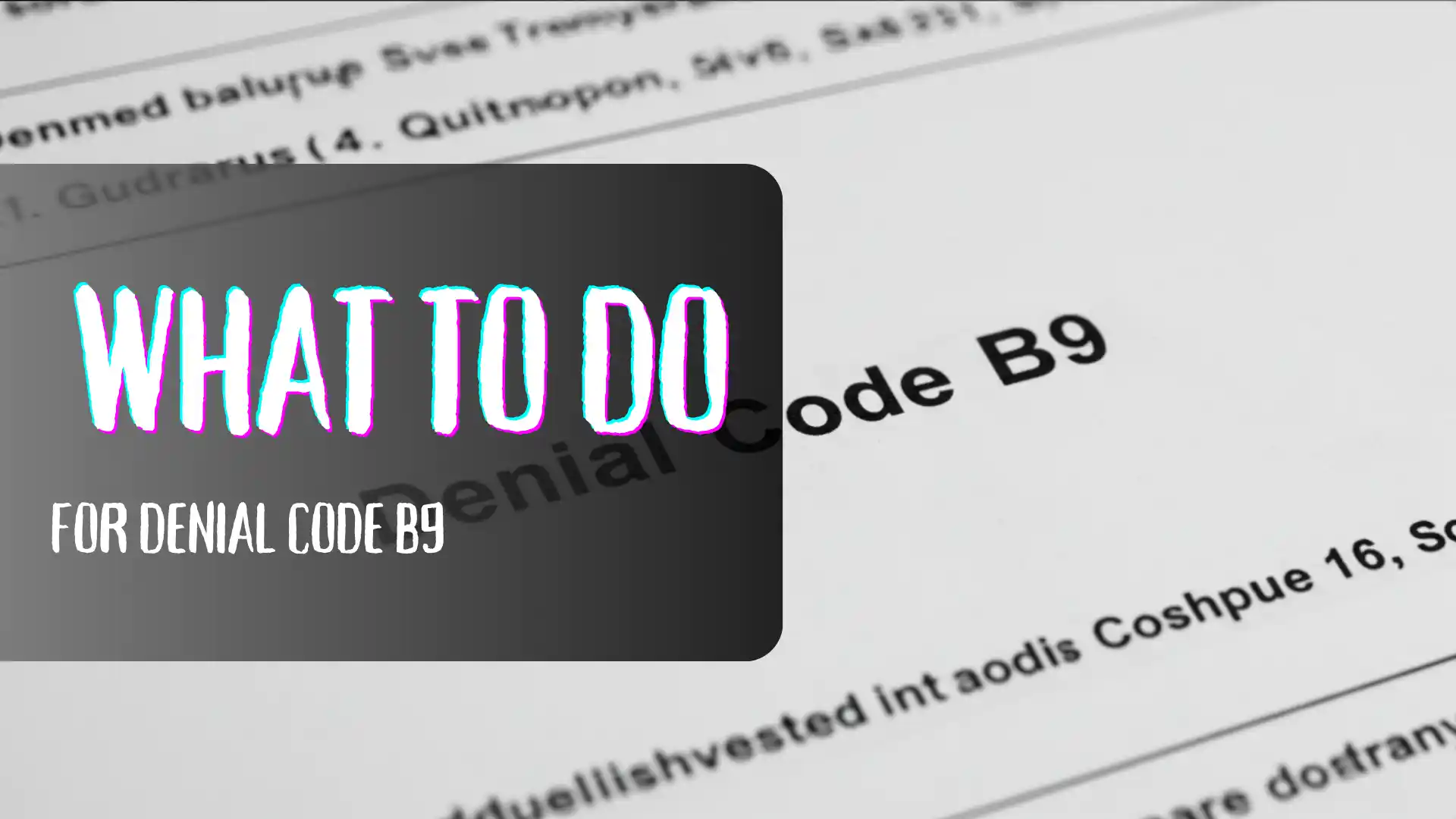What is the Denial Code B9
Before diving into what to do for denial code B9, it’s important to understand exactly what this code means. Denial code B9 typically indicates “Patient is enrolled in a Hospice Program.” This means the insurance company believes the patient was under hospice care when the service was provided, which affects how claims should be processed and which entity is responsible for payment.
When determining what to do for denial code B9, remember that hospice care is typically comprehensive, covering most services related to the terminal illness. When a patient elects hospice benefits, the hospice provider becomes responsible for managing and providing all care related to the terminal illness.
Common Reasons Why You’re Facing Denial Code B9

To effectively address what to do for denial code B9, you need to understand why this denial happens in the first place. Here are the most common scenarios:
- The patient is actually enrolled in hospice: The patient has elected hospice care, and your service may be the responsibility of the hospice provider.
- Outdated information in the payer’s system: The patient may have been discharged from hospice, but the insurance company’s records haven’t been updated.
- Patient misidentification: The insurance company may have confused your patient with someone else who is enrolled in hospice.
- Services unrelated to terminal illness: Your service might be unrelated to the terminal condition for which the patient is receiving hospice care.
Identifying the specific scenario is critical when determining what to do for denial code B9.
Verification Steps: Confirm Patient’s Hospice Status

The first actionable step in what to do for denial code B9 is verifying whether the patient was indeed under hospice care at the time of service. Here’s how to proceed:
- Check your patient’s medical records for any indication of hospice enrollment
- Contact the patient or patient’s family to confirm hospice status
- Call the insurance provider to verify their hospice information and effective dates
- If the patient is/was in hospice, contact the hospice provider to determine if your service falls under their responsibility
This verification step is crucial in your strategy for what to do for denial code B9, as it determines your next course of action.
Appeal Strategies When the Patient Was Not in Hospice Care
If you’ve confirmed the patient was NOT in hospice care when you provided the service, here’s what to do for denial code B9:
- Gather documentation: Collect evidence showing the patient was not in hospice at the time of service. This might include:
- Discharge papers from hospice if they were previously enrolled
- Written statement from the patient confirming they were not in hospice
- Documentation from the patient’s primary care provider
- Submit a formal appeal: When determining what to do for denial code B9, a well-crafted appeal is essential. Include:
- A clear statement that the patient was not enrolled in hospice
- All supporting documentation
- Request for immediate claim reprocessing
- Follow up actively: Don’t just wait for a response. Call the insurance company 7-10 days after submitting your appeal to check on its status.
Handling Claims When Services Were Unrelated to Hospice Diagnosis
Sometimes, what to do for denial code B9 involves demonstrating that your services were unrelated to the patient’s terminal condition. In these cases:
- Use modifier GW: This modifier indicates “Service not related to the hospice patient’s terminal condition.” When figuring out what to do for denial code B9 for unrelated services, applying the correct modifier is crucial.
- Provide clear documentation: Explain why the service was unrelated to the terminal illness. Include:
- The patient’s hospice diagnosis
- The condition you treated
- Medical justification for why these conditions are unrelated
- Include a physician statement: A letter from the treating physician explaining why the service was necessary and unrelated to the hospice diagnosis strengthens your case when deciding what to do for denial code B9.
Direct Billing: When to Bill the Hospice Provider Instead

An important aspect of what to do for denial code B9 involves understanding when to redirect your billing efforts. If the patient was indeed in hospice and your service was related to their terminal condition:
- Identify the hospice provider: Contact the patient or insurance company to determine which hospice agency was responsible for the patient’s care.
- Submit claims to the hospice provider: When determining what to do for denial code B9, remember that the hospice provider is responsible for paying for services related to the terminal illness.
- Include necessary documentation: Provide clinical notes and medical necessity documentation to support your claim to the hospice provider.
This redirection is often the correct answer to what to do for denial code B9 when the service was legitimately related to the hospice-covered condition.
Preventive Measures: Avoiding Future B9 Denials
An important part of understanding what to do for denial code B9 is learning how to prevent these denials in the future:
- Implement hospice screening questions: Train front-desk staff to ask patients about hospice enrollment during check-in.
- Verify benefits before service: Make hospice status verification part of your standard eligibility check process.
- Establish relationships with local hospice providers: Understanding their processes makes it easier to coordinate care and billing.
- Document thoroughly: Clear documentation about the relationship (or lack thereof) between your service and any terminal condition helps support claims.
These preventive measures are a crucial component of what to do for denial code B9 in the long term.
Timeframe Considerations: Acting Quickly on Denial Code B9
When considering what to do for denial code B9, timing is crucial. Most payers have strict deadlines for appeals:
- Check the deadline: Review the denial notice for the appeal timeframe, typically 30-180 days depending on the payer.
- Act promptly: Don’t delay verification and appeal submission.
- Calendar follow-ups: Set reminders to check on appeal status regularly.
Understanding these timeframes is an essential part of what to do for denial code B9 to ensure you don’t lose your right to appeal.
Medicare-Specific Guidelines for Handling B9 Denials
Medicare has specific procedures for what to do for denial code B9, which may differ from other payers:
- Understand Medicare hospice election periods: Medicare beneficiaries elect hospice for specific periods, and this affects what to do for denial code B9 with Medicare claims.
- Use condition code 07: For Medicare claims involving services unrelated to the terminal illness, this condition code indicates “Treatment of non-terminal condition for hospice patient.”
- Follow Medicare appeal processes: Medicare has a five-level appeal process with specific timeframes and documentation requirements.
These Medicare-specific guidelines are important to understand when determining what to do for denial code B9 for Medicare patients.
Working With Patients: Explaining Financial Responsibility

Sometimes, knowing what to do for denial code B9 involves patient communication:
- Explain the situation clearly: Help patients understand why their claim was denied and what it means for them.
- Discuss potential financial responsibility: If the service was unrelated to their terminal condition but appeals are unsuccessful, the patient may be responsible.
- Offer payment options: Be prepared to discuss financial assistance programs or payment plans if needed.
This patient communication aspect is an often-overlooked part of what to do for denial code B9.
When to Seek Expert Help With Denial Code B9
Some cases of denial code B9 may be complex, and knowing what to do for denial code B9 in these situations might involve seeking expert help:
- Consider a medical billing consultant: For persistent or complex hospice-related denials, specialized expertise can be valuable.
- Evaluate legal options: In cases of systematic incorrect denials, legal counsel might be appropriate.
- Industry associations: Organizations like AHIMA or AAPC may offer resources on what to do for denial code B9 in complex scenarios.
Don’t hesitate to seek expert help when standard approaches to what to do for denial code B9 aren’t yielding results.
Final Thoughts on Resolving Denial Code B9
Understanding what to do for denial code B9 requires a systematic approach and thorough understanding of hospice billing rules. By following the steps outlined in this guide, you can effectively address these denials and improve your chances of receiving appropriate reimbursement.
Remember that what to do for denial code B9 varies based on the specific circumstances of each case. Taking the time to properly investigate the hospice status, document appropriately, and follow through with appeals will maximize your success in overturning these denials.
For more information on handling other common medical billing challenges, you might find our other articles helpful:
- What to do after FastQC for healthcare research data analysis
- What to do if temporary crown falls off for dental professionals
- What to do when a rotten tooth falls out for patient education
By implementing these strategies for what to do for denial code B9, you’ll be better equipped to handle these challenging claims and maintain your practice’s financial health.








Leave a Comment